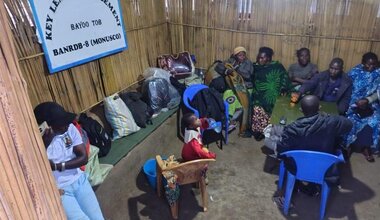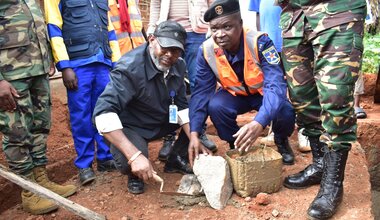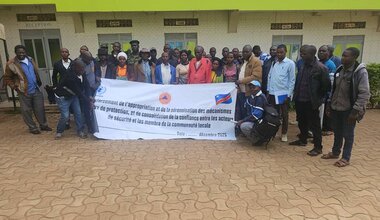Antonio Guterres visits Mangina, the first outbreak of the Ebola epidemic in eastern DR Congo
United Nations Secretary-General Antonio Guterres visited Mangina this Sunday, September 1, 2019, as part of a 72-hour visit to the Democratic Republic of the Congo.
In Mangina, North Kivu, groups of children playing around rammed houses; stalls are open at every corner of streets. In eastern DR Congo, in the very heart of the village where the Ebola virus disease was declared on August 1, 2018, life is going on as if nothing had happened. Yet it is in the heart of this farming village that the Ebola Treatment Center (ETC) is set up, next to the nursery run by the sisters of the Diocesan Office for Medical Works under the coordination of UNICEF.
Thus, this Sunday, September 1st, Antonio Guterres chose to go to Mangina, a symbolic place that is the very place where the Ebola epidemic disease broke out over a year ago. Epidemic which, despite the brief period of calm, is off again in early 2019.
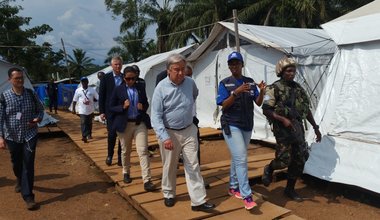
To date, there are more than 2000 people who died of the Ebola virus disease in the east of this vast country, including Beni, Katwa, Butembo, with cases reported in Goma and Bukavu (South Kivu) as well as in Uganda.
"Ebola remains a serious public health threat for the country and the region," Guterres said.
In July, the epidemic was declared a "health emergency of international concern" by the World Health Organization (WHO). In Mangina, the epidemic killed 285 people out of the 606 confirmed cases, the majority of whom being women and children under five.
Accompanied, inter alia, by Jean-Pierre Lacroix, Under-Secretary-General and Head of Peacekeeping Operations, Leila Zerrougui, Special Representative of the United Nations Secretary-General in the Democratic Republic of the Congo, and Dr. Tedros Adhamon Ghebreyesus, Director General, Mr. Guterres first met with representatives of the humanitarian component (World Health Organization, World Food Program, UNICEF, international NGOs such as Oxfam, Medair, Mercy Corps) that work on a daily basis to contain the outbreak.
Antonio Guterres then visited the ward A of the ETC, which welcomes patients suspected of having Ebola. Here, patients undergo various tests to find out whether or not they have contracted the disease. Mr. Guterres conferred with ECT's caregivers about their "extraordinary work" as well as their "courage".
Besides, He attended, along with WHO Director General, a ceremony during which certificates were issued to the patients who survived the Ebola virus disease and were officially cured. "You are heroes! "He told them, before adding:" Hero not only for having overcome the disease but also for being wise enough to rush to the ETC on time for treatment. "
Those who report on time to the ETC have the chance to get cured.
"We have this message for everyone: at the slightest suspicion, they should rush to the ETC for medical check," further said the Secretary General. "Those who report on time to the ETC have the chance to get cured. This message must be passed on to everyone. Do not hide the symptoms. Come, "he insisted, after meeting people who had been cured in the ETC compound. It is worth noting that people's resistance to the very existence of the disease is high, ranging from pure denial of the disease, refusal to receive care, violence reported towards the response teams, etc. The reasons for the resistance are numerous.
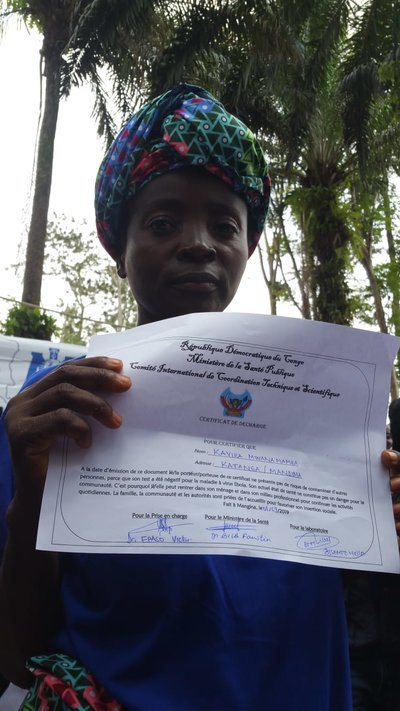
Among those who had the opportunity to speak with the UN chief was mwami Kapupa, representing traditional the chiefs in the region, who declared referring to the UNSG: "He came to comfort us in the face of the horrors we have experienced in our communities. We are facing a devastating disease that may be likened to war ".
The Secretary-General's visit also took him to the nursery next to the UNICEF-built ETC to accommodate children whose parents are suspected or suffering from the Ebola virus disease. It was on Sunday, September 1 that Mr. Guterres met Jospin, a nine-month-old baby whose mother is currently being cured of Ebola in the ETC. Jospin is assisted by Annie, one of the six "nursery staff" cured of Ebola in the ETC who babysit the children admitted in the nursery.
In his last visit to camp de vie de Mangina, Mr. Antonio Guterres was accompanied by Dr. Marie-Roseline Belizaire, the WHO coordinator of the Ebola response in Mangina. He was shown around the camp that has 31 tents in which are accommodated nearly 200 people (including about thirty women) all working daily for the humanitarian component present in Mangina. The Secretary-General warmly thanked "all those courageous people who give their best" in order to contain the disease.
Antonio Guterres flew to Beni in mid-afternoon, then to Kinshasa. In the Congolese capital city, Guterres is scheduled to meet with DRC President and Prime Minister on 2 September.
 UN
UN United Nations Peacekeeping
United Nations Peacekeeping




